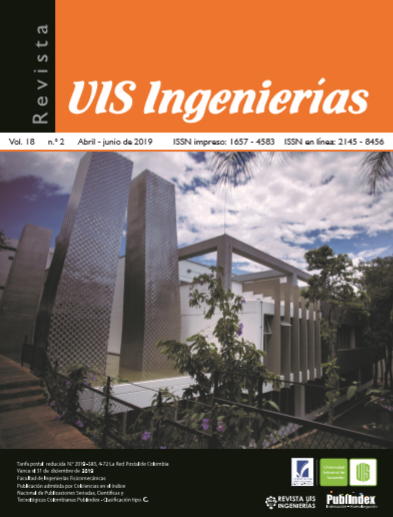Publicado 2019-03-11
Palabras clave
- Diseño energético de edificaciones,
- Simulación energética,
- Desempeño energético de edificios
Cómo citar
Resumen
La interpretación de resultados es una barrera que impide el uso frecuente de herramientas de simulación energética - HSE en el proceso de diseño de edificaciones. Además, crea requerimientos especiales de experiencia y conocimiento en los usuarios de las HSE, restringiendo su uso a profesionales expertos. Para facilitar en los usuarios menos experimentados la evaluación del desempeño energético de edificaciones tropicales se estableció una herramienta metodológica fundamentada en la evaluación comparativa por indicadores. Como valores de referencia, se adoptaron la línea base de la Resolución 0549 de 2015 (Colombia) y el edificio de referencia de la ASHRAE 90.1. Dicha herramienta permitió evaluar el desempeño energético de tres edificaciones, dos de tipo universitario y una residencial. A partir del uso esta herramienta se logró mejoras en el tiempo y la calidad de los resultados.
Descargas
Referencias
Unidad de Planeación Minero Energética - UPME, “Balance Energetico Colombiano - Beco”, [En línea]. Disponible en: http://www1.upme.gov.co/InformacionCifras/Paginas/BalanceEnergetico.aspx. [Accedido: 04-mar-2019].
Unidad de Planeación Minero Energética - UPME, “Escenarios de proyección de demanda,” 2015. [[En línea]. Disponible en: http://www.siel.gov.co/siel/Home/Demanda/tabid/60/Default.aspx. [Accedido: 05-Mar-2017].
G. A. Osma and G. Ordoñéz, “Desarrollo sostenible en edificaciones,” Rev. Uis Ing., vol. 9, no. 1, 2010.
Área Metropolitana del Valle de Aburrá and Universidad Pontificia Bolivariana, Política Pública de Construcción Sostenible: Linea Base, 2015.
Departamento Nacional de Planeación, “Política nacional de edificaciones sostenibles. CONPES 3919,” pp. 39, 2018.
G. Mustafaraj, D. Marini, A. Costa, and M. Keane, “Model calibration for building energy efficiency simulation,” Appl. Energy, vol. 130, pp. 72–85, 2014. doi: 10.1016/j.apenergy.2014.05.019
A. N. Sadeghifam, S. M. Zahraee, M. M. Meynagh, and I. Kiani, “Combined use of design of experiment and dynamic building simulation in assessment of energy efficiency in tropical residential buildings,” Energy Build., vol. 86, pp. 525–533, 2015. doi:10.1016/j.enbuild.2014.10.052
A. Dutta, A. Samanta, and S. Neogi, “Influence of orientation and the impact of external window shading on building thermal performance in tropical climate,” Energy Build., vol. 139, pp. 680–689, 2017. doi: 10.1016/j.enbuild.2017.01.018
L. Wang, X. Liu, and H. Brown, “Prediction of the impacts of climate change on energy consumption for a medium-size office building with two climate models,” Energy Build., vol. 157, pp. 218–226, 2017.
W. Bustamante, D. Uribe, S. Vera, and G. Molina, “An integrated thermal and lighting simulation tool to support the design process of complex fenestration systems for office buildings,” Appl. Energy, vol. 198, pp. 36–48, 2017. doi: 10.1016/j.apenergy.2017.04.046
X. Cui, B. Mohan, M. R. Islam, S. K. Chou, and K. J. Chua, “Energy performance evaluation and application of an air treatment system for conditioning building spaces in tropics,” Appl. Energy, vol. 204, pp. 1500–1512, 2017.doi: 10.1016/j.apenergy.2017.03.067
A. S. Silva, L. S. S. Almeida, and E. Ghisi, “Decision-making process for improving thermal and energy performance of residential buildings: A case study of constructive systems in Brazil,” Energy Build., vol. 128, pp. 270–286, 2016. doi: 10.1016/j.enbuild.2016.06.084
S. Attia, “State of the Art of Existing Early Design Simulation Tools for Net Zero Energy Buildings : A Comparison of Ten Tools,” en 12th Conference of International Building Performance Simulation Association, 2011.
D. Markovic, D. Cvetkovic, and B. Masic, “Survey of software tools for energy efficiency in a community,” Renew. Sustain. Energy Rev., vol. 15, no. 9, pp. 4897–4903, 2011.
C. M. Hui, “Building Energy Simulation Methods,” en Energy Performance of Air-conditioned Buildings in Hong Kong, 1996, pp. 168–223.
M. M. Mourshed, D. Kelliher, and M. Keane, “Integrating Building Energy Simulation in the design process,” IBPSA, vol. 13, pp. 21–26, 2003.
C. Morbitzer, P. Strachan, J. Webster, B. Spires, and D. Cafferty, “Integration of building simulation into the design process of an architecture,” en Eighth International IBPSA Conference, Netherlands, 2001, pp. 697–704.
M. K. Dixit, J. L. Fernández-Solís, S. Lavy, and C. H. Culp, “Identification of parameters for embodied energy measurement: A literature review,” Energy Build., vol. 42, no. 8, pp. 1238–1247, 2010.
C. J. Hopfe, “Uncertainty and sensitivity analysis in building performance simulation for decision support and design optimization,” tesis doctoral, University of Technology, 2009.
T. L. Hemsath, “Conceptual energy modeling for architecture , planning and design : impact of using building performance simulation in early design stages,” en 13th Conference of International Building Performance Simulation Association, 2013, pp. 376–384.
T. Hong, S. K. Chou, and T. Y. Bong, “Building simulation : an overview of developments and information sources,” Building and Environment, vol. 35, pp. 347–361, 2000. doi: 10.1016/S0360-1323(99)00023-2
D. B. Crawley, J. W. Hand, M. Kummert, and B. T. Griffith, “Contrasting the capabilities of building energy performance simulation programs,” Build. Environ., vol. 43, no. 4, pp. 661–673, Apr. 2008.
Advanced Energy Design Guide for Large Hospitals, ASHRAE, The merican Institute of Architects, Illuminating Engineering Society of North America, U.S Green Building Council, and U.S. Departament of Energy, 2012.
S. Attia and L. La Neuve, “Building Performance Simulation Tools : Selection Criteria and User Survey,” 2010. [En línea]. Disponible en: http://hdl.handle.net/2268/168350
L. Weytjens, S. Attia, G. Verbeeck, and A. De Herde, “A comparative study of the ‘ architect - friendliness ’ of six building performance simulation tools”, International Journal of Sustainable Building Technology and Urban Development, vol. 2, no. 3, pp. 237-244, 2012. doi: 10.5390/SUSB.2011.2.3.237
H. S. Rallapalli, “A comparison of EnergyPlus and eQUEST: Whole Building Energy Simulation Results for a Medium Sized Office Building,” tesis doctoral, Arizona State University, 2010.
Ashrae Handbook: Fundamentals, ASHRAE American Society of Heating Refrigerating and Air-Conditioning Engineers, vol. 30329, no. 404, 2009.
Integrated Design Process, International Energy Agency, no. april, 2003.
P. de Wilde, "Computational Support for the Selection of Energy Saving Building Components", en Eighth International IBPSA Conference, Netherlands, 2004, pp. 1409-1416.

